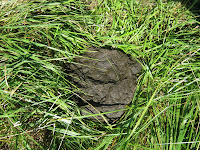Published Sep 24, 2010
Talkin’ Pasture Health (with Gompert)
By Kevin Dietzel
Terry Gompert, a Holistic Management educator, extension beef specialist, and grazier from Center, Nebraska, came to Central Iowa and toured two grazing farms on August 28, 2010. The two farms were Bill and Betty Kimble, and Ryan and Janice Marquardt.
Warning: there are pictures of manure in this blog post.
Terry Gompert relaxes on the porch with some of Betty Kimble’s coffee before the pasture walk.
Looking at manure is one of the best ways to determine if cows are getting the right balance of protein, energy, and fiber from the pasture. This is an example of an almost perfect consistency cowpie. It should have some vertical shape (not too runny), but have a slight dimple in the middle (not too dry or thick).
By smearing the manure a little with one’s foot, one can better assess the manure color. Very green, and there may be too little fiber (forage too immature and too high in protein, or too much selectivity), very yellow, and there may too much fiber (forage too mature or possible it’s time to move to a new paddock).
Here, Terry is digging underneath a cowpie to look for dung beetle burrows.
Terry talked about the importance of building a “litter two” layer, which is a darker layer of litter on the surface that is partially decomposed and is hard to distinguish from soil. This layer is litter that is being turned into new soil, adding organic matter, structure, and resilience to the system. It also helps insulate the soil from drying out or from temperature extremes, helping to keep the soil environment ideal for beneficial microorganisms.
Above is an apparatus that Bill Kimble bought that is supposed to trap biting flies. He would probably sell it pretty cheap to anyone who wants it, because he said it does not do much.
This is one of Bill’s waterers with a float valve to control water flow.
Each waterer is connected to the water line with quick couplers, for ease of movement.
The water lines are all gravity fed from this 5,000-gallon water tank he keeps at the highest point on his farm. He pumps water into the tank from his pond whenever the water gets below a certain level. Notice that he painted the water tank grey, which helps keep algae from growing on the inside of it. He also adds a small amount of chlorine each time he fills the tank. Terry says this may not be necessary, and may be killing off some of his beneficial organisms that would help with his overall ecosystem functioning. Terry suggested that apple cider vinegar may be just as effective, and also help with the health of his cows. He mentioned organic iodine as another potentially good substance to add to cattle’s drinking water periodically to help boost health.
Here are Terry Gompert and Bill Kimble (at the Marquardts’ farm).
This picture is kind of small, but here we can see the South Skunk River Valley and we can kind of see how far the flood waters were. We also see Ryan’s beautiful grassland with many native species.
This is one way to move minerals and keep them off the ground (plastic crate).
And finally, Bruce Carney resting with the lambs after a long day of pasture walking and talking.













